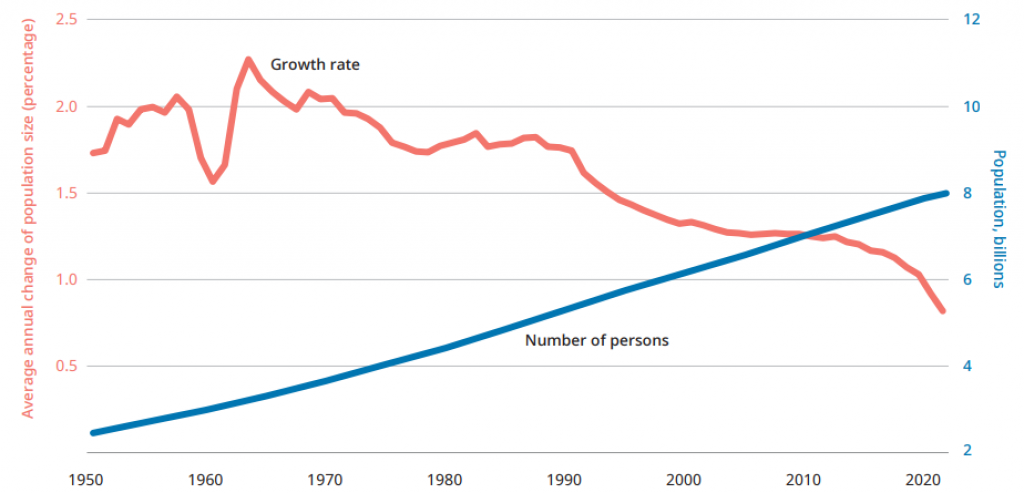

State of World Population 2023: Impact on economy, environment main concerns of citizens, finds perception survey



India will overtake China as the world’s most populous country this year, according to the United Nations Population Fund’s (UNFPA) State of World Population report released April 19, 2023. However, the UN body suggested focusing on women’s reproductive rights rather than the numbers.
UNFPA data estimates India’s population will go up to 1.4286 billion against 1.4257 billion for China by the middle of the year, according to the report tilted 8 Billion Lives, Infinite Possibilities: The Case for Rights and Choices. The report did not specify a date for when the change would take place.
United States Census Bureau World Population Clock in Janaury 2023 had reported that India had surpassed China as the world’s most populous nation. While India’s population was 1.42 billion as of January 18, China for the first time reported a fall of 850,000 since the 1960s and now stands at 1.41 billion.
Read more: China’s shrinking population may lead to xenophobia, threaten CCP’s hold on power: Geeta Kochhar
With a population of 340 million, the United States is a distant third, according to the demographic indicators in the report. The total world population was projected at 8.045 billion. India will also have the largest youth cohort — 254 million in the age range of 15-24 years.
The latest UNFPA report showed population growth in both India and China has been slowing, despite accounting for more than one-third of the estimated global population.
World population growth rate, 1950-2021

Source: UN DESA, 2022
India’s total fertility rate, or births per woman, was estimated at 2, lower than the world average of 2.3. Developed regions projected a fertility rate of 1.5, less developed regions 2.4 and least developed countries 3.9.
Read more: India projected to be world’s most populous country next year: UN Report
The average life expectancy for an Indian male was projected 71 and 74 for females. On average, the life expectancy for males globally was projected 71 and 76 for females. For developed regions, the average life expectancy for males was projected at 77 and 83 for females — the highest of all.
For less developed regions, the ages are 70 for males and 74 for females, while for least developed countries, it is 63 for males and 68 for females.
The report also brought up worrying statistics regarding gender rights in India. The adolescent birth rate per 1,000 girls aged 15–19 was 11, while 23 per cent of girls were married off before the age of 18.
Violence by an intimate partner in the last 12 months was reported by 18 per cent of women, while 66 per cent of women had decision-making on sexual and reproductive health and reproductive rights. A little over 80 per cent of women had some say in decision-making regarding their own healthcare.
About 63 per cent of Indians identified various economic issues as the top concerns when considering population change, followed by environmental concerns at 46 per cent.
Read more: India's population: Demographic changes along expected lines
Sexual and reproductive health and rights and human rights concerns were at 30 per cent.
Respondents in India believed that their country’s population was too large and fertility rates too high. There was no significant difference between the views of men and women in India on national fertility rates.
Views on global fertility rate held by survey respondents

Source: UNFPA / YouGov Survey 2022
“As the world reaches 8 billion people, we at UNFPA see India’s 1.4 billion people as 1.4 billion opportunities,” said Andrea Wojnar, representative UNFPA India, in the report.
With almost half the population under 25 years of age, India has a time-bound opportunity to benefit from the demographic dividend, it said. The focus should be on giving women more power to control when and how they have children, the authors added.
“Ensuring gender equality, empowerment and advancing greater bodily autonomy for women and girls—is one of the key determinants of a sustainable future,” the report said.
Global experience has shown that family planning targets can lead to gender-based discrimination and other harmful practices, it added.
“Deleterious effects of such targets include prenatal sex determination leading to sex-selective abortion and imbalanced sex ratios, preferential health and nutrition for male children, denial of the paternity of female children, violence against women for giving birth to girl children and coercion of women to have fewer or greater numbers of children,” it added.
We are a voice to you; you have been a support to us. Together we build journalism that is independent, credible and fearless. You can further help us by making a donation. This will mean a lot for our ability to bring you news, perspectives and analysis from the ground so that we can make change together.

Comments are moderated and will be published only after the site moderator’s approval. Please use a genuine email ID and provide your name. Selected comments may also be used in the ‘Letters’ section of the Down To Earth print edition.